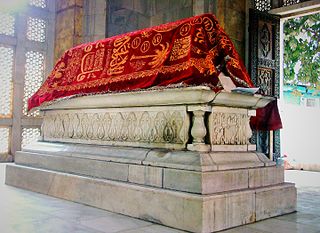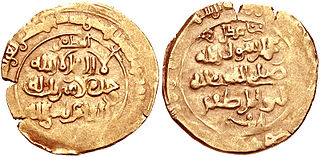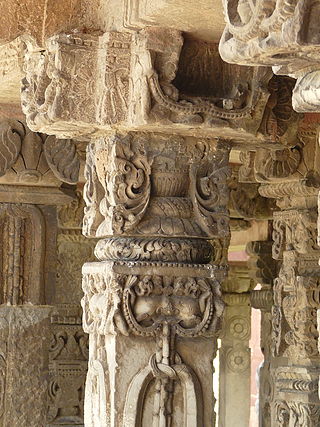Related Research Articles

The Delhi Sultanate or the Sultanate of Delhi was a late medieval empire primarily based in Delhi that stretched over large parts of the Indian subcontinent, for 320 years (1206–1526). Following the invasion of South Asia by the Ghurid dynasty, five dynasties ruled over the Delhi Sultanate sequentially: the Mamluk dynasty (1206–1290), the Khalji dynasty (1290–1320), the Tughlaq dynasty (1320–1414), the Sayyid dynasty (1414–1451), and the Lodi dynasty (1451–1526). It covered large swaths of territory in modern-day India, Pakistan, and Bangladesh as well as some parts of southern Nepal.

The Ghaznavid dynasty or the Ghaznavid Empire was a Persianate Muslim dynasty and empire of Turkic mamluk origin, ruling at its greatest extent from the Oxus to the Indus Valley from 977 to 1186. The dynasty was founded by Sabuktigin upon his succession to the rule of Ghazna after the death of his father-in-law, Alp Tigin, who was an ex-general of the Samanid Empire from Balkh.

Abu al-Qasim Mahmud ibn Sabuktigin, usually known as Mahmud of Ghazni or Mahmud Ghaznavi, was Sultan of the Ghaznavid Empire, ruling from 998 to 1030. During his reign and in medieval sources, he is usually known by his honorific Yamin al-Dawla. At the time of his death, his kingdom had been transformed into an extensive military empire, which extended from northwestern Iran proper to the Punjab in the Indian subcontinent, Khwarazm in Transoxiana, and Makran.

Mu'izz ad-Din Muhammad ibn Sam, also known as Muhammad of Ghor or Muhammad Ghori, was a ruler from the Ghurid dynasty based in the Ghor region of what is today central Afghanistan who ruled from 1173 to 1206. Muhammad and his elder brother Ghiyath al-Din Muhammad ruled in a dyarchy until the latter's death in 1203. Ghiyath al-Din, the senior partner, governed the western Ghurid regions from his capital at Firozkoh whereas Muhammad extended Ghurid rule eastwards, laying the foundation of Islamic rule in South Asia, which lasted after him for nearly half a millennium under evolving Muslim dynasties.

Qutb ud-Din Aibak, was a general of the Ghurid emperor Muhammad Ghori. He was in charge of the Ghurid territories in northern India, and after Muhammad Ghori's assassination in 1206, he established the Delhi Sultanate (1206–1526), and started the Mamluk dynasty, which would rule the Sultanate until 1290.
The Ghurid dynasty was a Persianate dynasty of presumably eastern Iranian Tajik origin, which ruled from the 8th-century in the region of Ghor, and became an Empire from 1175 to 1215. The Ghurids were centered in the hills of the Ghor region in the present-day central Afghanistan, where they initially started out as local chiefs. They gradually converted to Sunni Islam after the conquest of Ghor by the Ghaznavid ruler Mahmud of Ghazni in 1011. The Ghurids eventually overran the Ghaznavids when Muhammad of Ghor seized Lahore and expelled the Ghaznavids from their last stronghold.

Ahmad ibn Umar ibn Alī, known as Nizamī-i Arūzī-i Samarqandī and also Arudi, was a poet and prose writer who flourished between 1110 and 1161. He is particularly famous for his Chahar Maqala, his only work to fully survive. While living in Samarqand, Abu’l-Rajaʾ Ahmad b. ʿAbd-Al-Ṣamad, a dehqan in Transoxiana, told Nezami of how the poet Rudaki was given compensation for his poem extolling the virtues of Samanid Amir Nasr b. Ahmad.

Taj al-Din Yildiz was a Turkic ghulam of the Ghurid dynasty, who, after the death of Sultan Muhammad of Ghor, became the de facto ruler of Ghazni, while, however, still recognizing Ghurid authority.

Ikhtiyār al-Dīn Muḥammad Bakhtiyār Khaljī, also known as Bakhtiyar Khalji, was a Turko-Afghan military general of the Ghurid ruler Muhammad of Ghor, who led the Muslim conquests of the eastern Indian regions of Bengal and parts of Bihar and established himself as their ruler. He was the founder of the Khalji dynasty of Bengal, which ruled Bengal for a short period, from 1203 to 1227 CE.

Ghiyath al-Din Muhammad, also known as Ghiyath al-Din Ghori or Ghiyassuddin Ghori born, Muhammad, was the Sultan of the Ghurid dynasty. During the diarchy of Ghiyath and his younger brother Muhammad of Ghor, who governed the eastern realm of the Ghurid Empire, the Ghurids emerged as one of the greatest powers of the eastern Islamic world.
The Tarikh i Yamini, or Kitab i Yamini, written in Arabic in an embellished, flowery rhetorical rhymed prose, is a history of the reigns of Sebuktigin and Mahmud.

Ibrahim of Ghazna was sultan of the Ghaznavid empire from April 1059 until his death in 1099. Having been imprisoned at the fortress of Barghund, he was one of the Ghaznavid princes that escaped the usurper Toghrul's massacre in 1052. After his brother Farrukh-Zad took power, Ibrahim was sent to the fortress of Nay, the same fortress where the poet Masud Sa'd Salman would later be imprisoned for ten years.
Tabaqat-i Nasiri, named for Sultan Nasir-ud-Din, is an elaborate history of the Islamic world written in Persian by Minhaj-i-Siraj Juzjani and completed in 1260. Consisting of 23 volumes and written in a blunt straightforward style, Juzjani devoted many years to the creation of this book even providing references for his information. Although a large portion of the book is devoted to the Ghurids, it also contains a history of the predecessors in Ghazna before the Ghaznavid Sebuktigin took power. In compiling his Tabaqat i Nasiri, Juzjani used other books now lost; part of Baihaqi's reign of Sebuktigin, Abu'l-Qasim Imadi's Ta'rikh-i mujadwal and most likely Ibn Haisam's Qisas-i thani. Juzjani's "tabaqat" would initiate the form of writing for dynastic history in centuries to come.
Abu'l-Muzaffar Khusrau Malik ibn Khusrau-Shah, better known simply as Khusrau Malik, was the last Sultan of the Ghaznavid Empire, ruling from 1160 to 1186. He was the son and successor of Khusrau Shah.
The Battle of Andkhud, also spelt as Battle of Andkhui, alternatively known as the Catastrophe of Andkhud was fought in 1204 on the bank of river Oxus near Andkhoy in present-day Afghanistan. It was fought between the Ghurid forces of Muhammad of Ghor against the Qara Khitai forces led by Tayangu of Taraz. The battle ended in a complete rout of the Ghurids, although Muhammad of Ghor managed to escape the debacle after the intervention by Uthman of Qarakhanid.

The Ghurid campaigns in India were a series of invasions for 31 years (1175–1206) by the Ghurid ruler Muhammad of Ghor in the last quarter of the twelfth and early decade of the thirteenth century which lead to the widespread expansion of the Ghurid empire in the Indian subcontinent.
The Siege of Lahore (1186) was part of the military expedition of Ghurids during which the Ghurid ruler Muhammad of Ghor annexed the principality of the Ghaznavids in Lahore after overthrowing the last Ghaznavid ruler Khusrau Malik.

Malik Bahauddin Tughril, commonly known as Bahauddin Tughril or Baha al-Din Tughril was a senior Turkic slave of the Ghurid ruler Muhammad of Ghor who was in charge of the Bayana region in the present-day Indian state of Rajasthan. He was admitted into the slave-household of the Ghurids during early reign of Muhammad of Ghor and gradually emerged as one of his eminent slave lieutenant along with Qutb al-Din Aibak, playing a significant role in the Ghurid conquest of northern Indian plain.
References
- ↑ Eliot and Dowson, The History of India, as Told by Its Own Historians , Vol.2, 286.
- ↑ History of Civilizations of Central Asia, C.E. Bosworth, M.S. Asimov, p. 185.
- 1 2 Ghurids, C.E. Bosworth, Encyclopedia of Islam, Vol.2, ed. Bernard Lewis, C. Pellat and J. Schacht, (E.J.Brill, 1991), 1100.
- ↑ C.E. Bosworth, The Later Ghaznavids, 113-114.
- ↑ Jaques 2007, p. 392
- 1 2 The Iranian World, C.E. Bosworth, The Cambridge History of Iran, Vol. 5, ed. J. A. Boyle, John Andrew Boyle, (Cambridge University Press, 1968), 163.
- ↑ Andre Wink (1991). Al-Hind the Making of the Indo-Islamic World: The Slave Kings and the Islamic Conquest : 11Th-13th Centuries. BRILL. p. 245. ISBN 9004102361.
- ↑ Andre Wink, Al-Hind: The Making of the Indo-Islamic World, Vol. 2, 244.
- ↑ Andre Wink (1991). Al-Hind the Making of the Indo-Islamic World: The Slave Kings and the Islamic Conquest : 11Th-13th Centuries. BRILL. p. 244. ISBN 9004102361.
- ↑ Mohammad Habib (1981). K. A. Nizami (ed.). Politics and Society During the Early Medieval Period: Collected Works of Professor Mohammad Habib. People's Publishing House. p. 111.
- ↑ Ghaznavids, C.E. Bosworth, Encyclopedia Iranica
- ↑ Encyclopedia Iranica, Ghurids, Edmund Bosworth, Online Edition 2007, ()
- 1 2 A Global Chronology of Conflict: From the Ancient World to the Modern Middle East, Vol. I, ed. Spencer C. Tucker, (ABC-CLIO, 2010), 263.
- ↑ Jain, Meenakshi (2011-01-01). THE INDIA THEY SAW (VOL-2): Bestseller Book by Meenakshi Jain: THE INDIA THEY SAW (VOL-2). Prabhat Prakashan. p. 240. ISBN 978-81-8430-107-6.
- ↑ Carnegy, P. (1873). "Benoudha, Part III". Calcutta Review. 56 (109): 43–58, pages 50 to 52.
- ↑ K. A. Nizami (1970). "FOUNDATION OF THE DELHI SULTANAT". In Mohammad Habib; Khaliq Ahmad Nizami (eds.). A Comprehensive History of India: The Delhi Sultanat (A.D. 1206-1526). Vol. 5 (Second ed.). The Indian History Congress / People's Publishing House. p. 171. OCLC 31870180.
In 592/1195-96 Muizzuddin again carme to India. He attacked Bayana, which was under Kumarapala, a Jadon Bhatti Rajput. The ruler avoided a confrontation at Bayana, his capital, but went to Thankar and entrenched himself there. He vas, howvever, compelled to surrender. Thankar and Vijayamandirgarh were occupied and put under Bahauddin Tughril
- ↑ Ahmad Hasan Dani et al. History of civilizations of Central Asia, vol. IV, Delhi, Motilal Banarsidass Pub. (1999) ISBN 81-208-1409-6, p182
- ↑ Enc. Islam, article: Muhammad, Mu'izz al-Din
- ↑ Michel Biran, The Empire of the Qara Khitai in Eurasian History, (Cambridge University Press, 2005), 70.